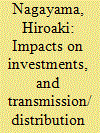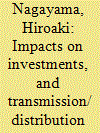|
|
|
Sort Order |
|
|
|
Items / Page
|
|
|
|
|
|
|
| Srl | Item |
| 1 |
ID:
097504


|
|
|
|
|
| Publication |
2010.
|
| Summary/Abstract |
This study analyses original panel data from 86 countries between 1985 and 2006. Econometric methods were used to identify the effects of different policy devices of power sector reforms on performance indicators (installed capacity per capita, transmission and distribution loss) in the countries analyzed. The research findings suggest that reform variables such as the entry of independent power producers (IPPs), unbundling of generation and transmission, establishment of regulatory agencies, and the introduction of a wholesale spot market are the driving forces of increasing generation capacity, as well as reducing transmission and distribution loss in the respective regions. In this study, we can assume that, firstly, different electric industry's reform policies/measures have different impacts on geographically and economically diverse countries. Secondly, a country's state of economic development has a different impact on policy effects of reforms. Thirdly, coexistent with independent regulatory agencies, reform policy becomes more powerful in realizing sector performances.
|
|
|
|
|
|
|
|
|
|
|
|
|
|
|
|
| 2 |
ID:
094876


|
|
|
|
|
| Publication |
2010.
|
| Summary/Abstract |
Supply of piped gas in China has a long history but development was slow until the 21st century. The growing demand for cleaner fuel in the past ten years has encouraged domestic exploration and production of natural gas (NG) and the construction of long-haul pipelines linking upstream western regions of the country to downstream city-gas consumers in the eastern coastal areas. However, demand for NG in the cities is increasing so fast that recent winters have seen severe supply difficulties. This led to a government directive which set constraints on the domestic NG supplies and discouragement to gas power and petrochemical projects, and eventually to the Chinese government's willingness to accept the higher prices commanded by the international NG market. Nevertheless, the over demand situation has created a dominant market position for upstream NG producers and long-haul pipeline operators favouring their forward integration into downstream city-gas markets. Accordingly, pressures are building that may yet result in substantial pricing and regulatory reform in the city-gas industry.
|
|
|
|
|
|
|
|
|
|
|
|
|
|
|
|
| 3 |
ID:
096712


|
|
|
|
|
| Publication |
2010.
|
| Summary/Abstract |
This study analyses original panel data from 86 countries between 1985 and 2006. Econometric methods were used to identify the effects of different policy devices of power sector reforms on performance indicators (installed capacity per capita, transmission and distribution loss) in the countries analyzed. The research findings suggest that reform variables such as the entry of independent power producers (IPPs), unbundling of generation and transmission, establishment of regulatory agencies, and the introduction of a wholesale spot market are the driving forces of increasing generation capacity, as well as reducing transmission and distribution loss in the respective regions. In this study, we can assume that, firstly, different electric industry's reform policies/measures have different impacts on geographically and economically diverse countries. Secondly, a country's state of economic development has a different impact on policy effects of reforms. Thirdly, coexistent with independent regulatory agencies, reform policy becomes more powerful in realizing sector performances.
|
|
|
|
|
|
|
|
|
|
|
|
|
|
|
|
| 4 |
ID:
097505


|
|
|
|
|
| Publication |
2010.
|
| Summary/Abstract |
This study analyses original panel data from 86 countries between 1985 and 2006. Econometric methods were used to identify the effects of different policy devices of power sector reforms on performance indicators (installed capacity per capita, transmission and distribution loss) in the countries analyzed. The research findings suggest that reform variables such as the entry of independent power producers (IPPs), unbundling of generation and transmission, establishment of regulatory agencies, and the introduction of a wholesale spot market are the driving forces of increasing generation capacity, as well as reducing transmission and distribution loss in the respective regions. In this study, we can assume that, firstly, different electric industry's reform policies/measures have different impacts on geographically and economically diverse countries. Secondly, a country's state of economic development has a different impact on policy effects of reforms. Thirdly, coexistent with independent regulatory agencies, reform policy becomes more powerful in realizing sector performances.
|
|
|
|
|
|
|
|
|
|
|
|
|
|
|
|
| 5 |
ID:
121555


|
|
|
|
|
| Publication |
2013.
|
| Summary/Abstract |
Chile has a dire need as well as a vast potential to expand renewable energy production and the government has recently introduced regulatory reforms and incentives to facilitate their development. Nevertheless, the governance structure of the electricity sector poses significant barriers to the attainment of national energy aims. Actors from the state, private sector, as well as civil society must tackle the main constraints to provide a cohesive and targeted policy response to the issue.
|
|
|
|
|
|
|
|
|
|
|
|
|
|
|
|
|
|
|
|
|